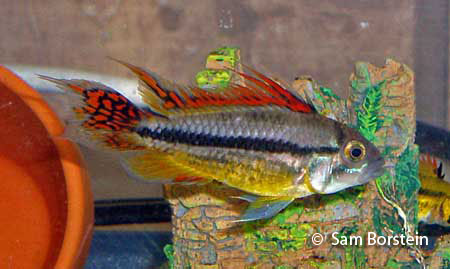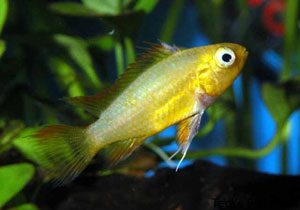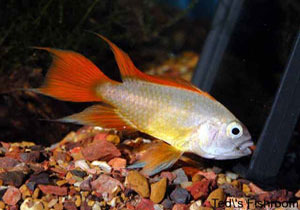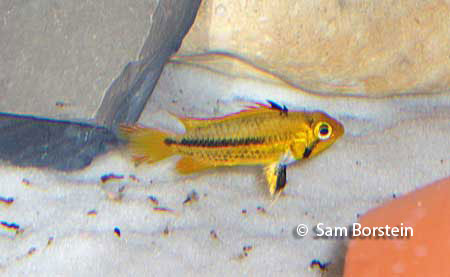Apistoramma cacatuoides
Hoedeman, 1951
Cockatoo Dwarf Cichlid

Above: A male Apistogramma cacatuoides. Photo by Sam Borstein.
Etymology:
Genus- Apisto= uncertain (Greek), gramma= line (Greek)
Species- cacatu= cockatoo (Malaysian), oides= like (Greek)
Intro:
Apistogramma cacatuoides is one of the most established dwarf cichlids in the hobby. This South American dwarf is easy to obtain and keep because they are tolerant of many water parameters.
This fish is also line bred overseas, creating a few variants that are much more popular than the wild types seen today. Most of these linebred forms have lots of color, which is primarily lacking in the wild caught fish.
The most popular line bred forms are:
- Orange Flash- Solid orange through the anal, dorsal, and caudal fin.
- Double Red- Orange and black markings in Caudal and dorsal fin.
- Triple Red- O range and black marking throughout the anal, dorsal, and caudal fin.
- Gold- Available in orange flash, double red, and triple red.


Above: A pair of the "Gold" form of Apistogramma cacatuoides. Male on right, female on left. Photo courtesy of Ted Judy.
Distribution:
Apistogramma cacatuoides occurs in the Rio Ucayali in Peru among leaf litter.
Size, Maturity, and Sexual Dimorphism:
Size: Males- 3 inches, Females- 2 inches
Maturity: 1.5 inches
Sexual Dimorphism: Males are larger than females and are gray in body color with colorful fins. Females are brown to yellow with black markings on the body.
Care:
Apistogramma cacatuoides is easy to care for. Because this fish accepts a wide range of water values, it is not hard to keep them happy. For an Apisto, they can be kept and bred in hard water with a pH of 7-8. It is important to note that the fish will display better colors in softer more acidic water. The fish are not very aggressive either and are easily kept in small tanks. A breeding pair can be kept in a 10 gallon.
Diet:
Apistogramma cacatuoides is a carnivore and eats insect larvae in the wild. In aquaria, it will gladly eat anything. I fed mine spectrum and various flake foods. I did have lots of success conditioning the pair on live foods such as brine shrimp.
Breeding:
Apistogramma cactuoides is easy to breed. Unlike most Apistos, they do not need soft water. Females must be conditioned well before spawning, but will breed easily. Before spawning both the males and females colors will intensify, but the females are most noticeable as she will turn almost neon yellow.
These fish are cave spawners, so provide a small cave for spawning to occur. Females lay between 20 and 60 eggs, which are orange-red in color. The eggs are guarded by the female while the male guards the territory. The eggs hatch in about 4 days and are free swimming within a week.
Fry are guarded well by the parents and are easy to raise on baby brine shrimp. They fry grow fast and within 3 months, males will develop markings in their fins.

Above: A female Apistogramma cacatuoides in breeding color over fry. Photo by Sam Borstein.
Conclusion:
Apistogramma cacatuoides is a nice little fish to keep. I highly recommend them to anyone who is starting with cichlids, wants cichlids in their community tank, or is starting with Apistogramma.
